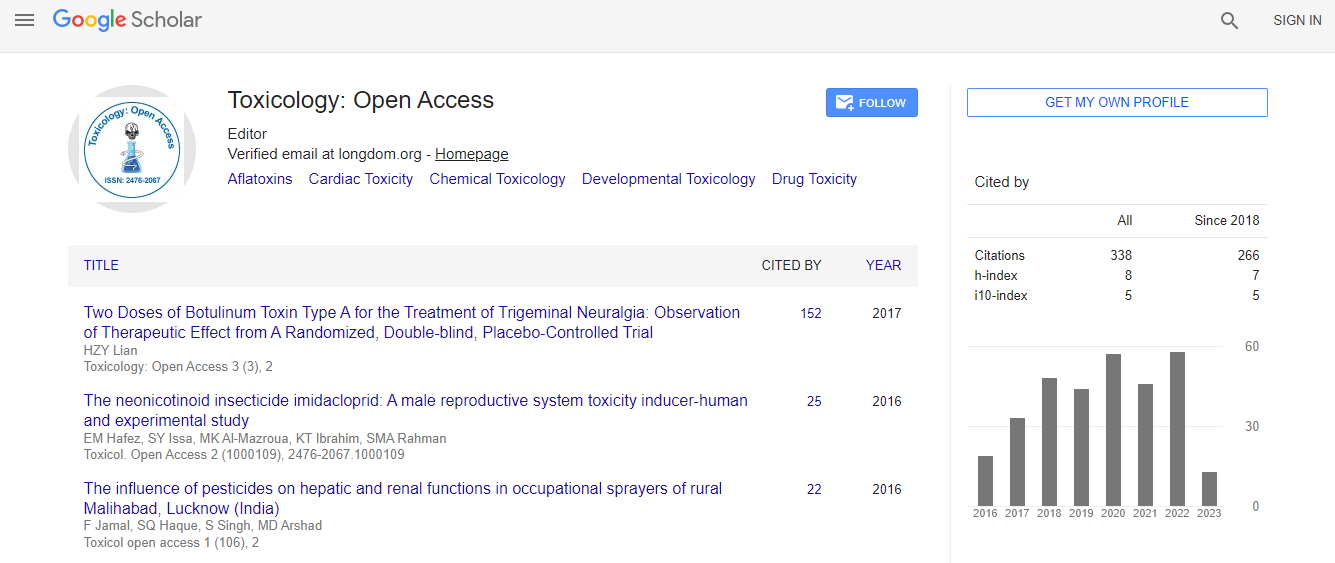Our Group organises 3000+ Global Conferenceseries Events every year across USA, Europe & Asia with support from 1000 more scientific Societies and Publishes 700+ Open Access Journals which contains over 50000 eminent personalities, reputed scientists as editorial board members.
Open Access Journals gaining more Readers and Citations
700 Journals and 15,000,000 Readers Each Journal is getting 25,000+ Readers
Google Scholar citation report
Citations : 336
Toxicology: Open Access received 336 citations as per Google Scholar report
Indexed In
- Google Scholar
- RefSeek
- Hamdard University
- EBSCO A-Z
- Geneva Foundation for Medical Education and Research
- Euro Pub
- ICMJE
Useful Links
Related Subjects
Share This Page
AFLATOX: A biotechnological approach for the development of new antifungal compounds to protect the environment and the human health
14th World Congress on Toxicology and Pharmacology
Annamaria Buschini, Serena Montalbano, Marianna Pioli, Fancesca Degola, Giorgio Pelosi, Franco Bisceglie, Nicolo Orsoni, Mauro Carcelli, Jennifer Bartoli, Francesco M Restivo, Dominga Rogolino, Claudia Zani and Donatella Feretti
University of Parma, Italy University of Brescia, Italy
Posters & Accepted Abstracts: Toxicol Open Access
Abstract
The aim of the Aflatox project (www.aflatox.it) is the development of an innovative biotechnological multi-step approach to design and test new compounds with a biological activity on fungi. The full-experimental database that we have been creating constitutes a powerful source of data to identify important requirements to be taken into account for the development of new generation pesticides, responding to ├ó┬?┬?greener├ó┬?┬Ł and environmentally sustainable agricultural strategies. In particular, the compounds must be active against phytopathogenic genera contaminating cereals and food/feed derivatives, with a particular focus on aflatoxigenic species. The requirements to become a good candidate, are not only the high effectiveness in preventing fungal proliferation and mycotoxin biosynthesis, but also the non-toxicity for the environment and the human health. The project has been divided into three different sections: the first is the design and synthesis of some parent compounds from natural molecules, the second is the study of their biological effect and cytotoxicity, and the third is the chemical modification of the most active compounds in order to study the mechanism of action and to improve the biological activity. In particular, in this last stage of the project, the compounds which had shown good results were modified not only in their chemical scaffold, but also used as chelating agents for bio-metal ions like zinc, copper or iron. At present, we have managed to create a database containing a panel of 162 compounds which have been synthesized, characterised and tested for antifungal and antimicotoxigenic properties. Toxicological and genotoxicological evaluation were conducted on normal human cell lines and A. cepa root apex. All these data have been collected in a database that will allow us to produce Q-SAR (Quantitative structureactivity relationship) evaluation profiles. Recent Publications 1. Perotti A, Rossi V, Mutti A, Buschini A (2015) Methy-sens Comet assay and DNMTs transcriptional analysis as a combined approach in epigenotoxicology. Biomarkers; 20:64-70. 2. Degola F, Morcia C, Bisceglie F, Mussi F, Tumino G, Ghizzoni R, Pelosi G, Terzi V, Buschini A, Restivo FM, Lodi T (2015) In vitro evaluation of the activity of thiosemicarbazone derivatives against mycotoxigenic fungi affecting cereals. International Journal of Food Microbiology; 200:104-111. 3. Zani C, Bisceglie F, Restivo FM, Feretti D, Pioli M, Degola F, Montalbano S, Galati S, Pelosi G, Viola GVC, Carcelli M, Rogolino D, Ceretti E, Buschini A (2017) A battery of assays as an integrated approach to evaluate fungal and mycotoxin inhibition properties and cytotoxic/genotoxic side-effects for the prioritization in the screening of thiosemicarbazone derivatives. Food and Chemical Toxicology; 105:498-505. 4. Rogolino D, Gatti A, Carcelli M, Pelosi G, Bisceglie F, Restivo FM, Degola F, Buschini A, Montalbano S, Feretti D, Zani C (2017) Thiosemicarbazone scaffold for the design of antifungal and antiaflatoxigenic agents: evaluation of ligands and related copper complexes. Scientific Reports; 7:11214. 5. Dellafiora L, Perotti A, Galaverna G, Buschini A, Dall'Asta C (2016) On the masked mycotoxin zearalenone-14-glucoside. Does the mask truly hide? Toxicon; 111:139-42.Biography
Annamaria Buschini is a genotoxicologist. Her main research interests are environmental mutagenicity and the study of the toxicological profile of drugs/ phytochemicals. From the beginning of her research career, she worked on eukaryotic model-systems to study the interaction between xenobiotics (environmental pollutants, drugs, etc) and the cellular environment. One of the goals of this long-term project was to build up and validate screening systems able to detect different mutagenic events at the molecular level for a quantitative/qualitative evaluation of the “genetic hazard”. In recent years, she has been involved in epigenotoxicological studies.
Email:annamaria.buschini@unipr.it

 Spanish
Spanish  Chinese
Chinese  Russian
Russian  German
German  French
French  Japanese
Japanese  Portuguese
Portuguese  Hindi
Hindi 